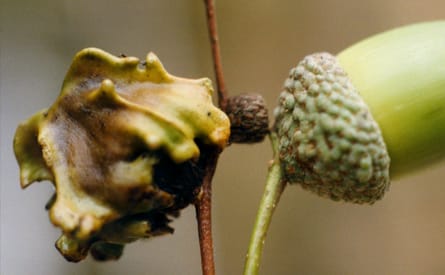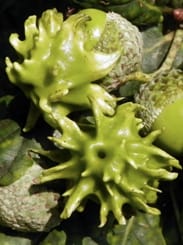
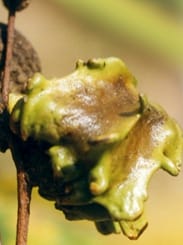
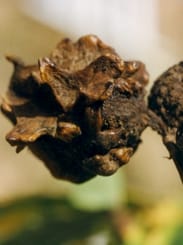
Oak Galls (Andricus quercuscalicis)
Proving date: 1998
Proving completed by: Misha Norland
Common name : Oak Galls
Download: Full proving Oak Galls (Andricus Quercuccalicis)
Download: Proving rubrics
About Oak Galls
Ugly outcast, homesick, like a parasite working hard to be attractive.
Patients needing this remedy believe they are ugly, loathsome, that they have become infected and must be shunned, even banished. They may feel plotted against. As one prover put it, 'They perceive me as a user of people; that I do things to get what I need at their expense; that I am a parasite.' They become suspicious, thinking people are hiding things from them. They feel the animosity and hatred of others and react by becoming secretive, or broodingly angry; bursting with explosive violence. There may be a sensation of levitation, floating, flying, and of being sucked up as if by a vacuum cleaner. Sensation of things being blown upwards. At other times they may feel relaxed. They feel calm, light-headed, giggling, euphoric and cheerful. Desire to make people smile. They want to laugh. There are themes of sexuality, pregnancy, and swelling up.
Stiffness of thoracic spine, right side of neck, and right leg. Constriction of the heart. Sensations: heat radiating out from body/coldness on the surface of entire body. Coldness of finger tips and hands, and coldness of back. Pressure on chest as if they could not breathe. Pulsations in whole body.
Oak gall
The acorn or knopper gall wasp (Andricus quercuscalicis) of the Cynipidae family, is a parasitic insect that induces knopper galls on pedunculate oak trees. There is no known evidence that explains inducement for the formation of the gall, however many speculate that there are chemical, mechanical and viral triggers. In early Summer, the wasps lay eggs in the developing cupules of Quercus robur, stimulating the oak tree into producing a gall rather than a cup and acorn. The gall provides developing knopper gall wasps with a safe refuge – protective cover from external environmental factors – during the most vulnerable time of their life cycle. Galls are sticky and green, later becoming woody and brown, and smell oddly sweet and rancid. They are extraordinary to behold – a ridged and horned hood of smooth green wood. Even though knopper gall wasps have little effect on the general health of a tree, galls can reduce reproduction in the oak host thereby making the gall a potential threat to the proliferation of the tree.
Reproduction of knopper gall wasps relates to the seasons, with alternating generations being asexual or sexual. The generation born in the Summer consists of both males and females and reproduces sexually, however those that emerge in late Winter to Spring are only female. The male is winged and flies away to fertilise other females whereas most females are wingless. The females of both forms have ovipositors that are designed to pierce a hole in the bud on the oak tree, and then place the egg within. The larvae grows and pupates within the gall, feeding on its rich nutrients. When developed, the adult insect exits the gall by eating a path out of it, through a depression at the centre of the horned hood, from where it emerges.
Oak is the best known and loved of English trees, and they can live for up to 500 years. The tree supports a great diversity of parasitic life and many food chains. The rich nutrition and protection afforded by the gall is attractive to many insects that also lay their eggs in the developing gall and as many as 30 different species have been observed emerging from a single gall.
Mythology
Celtic astrology: The oak tree is seen as the stabiliser and those born under this tree are seen to have a special gift of strength. They are described as protective people who will speak out for those who have no voice. The oak tree is a crusader that is nurturing, generous and helpful and is seen as a gentle giant among the Celtic zodiac signs. Those under this sign will be confident and positive, living long and happy lives, enjoying family, also and social and community time. They like structure, often with a great need for the feeling of control.
Oak crown leaves: were worn by ancient kings to symbolise the gods that they represented on Earth. This high regard for oak held by the Celts filtered through to Christian religion and many historic churches were built near the sites of pagan oak groves. Carvings of oak leaves, acorns and galls can be found in many parish churches, and in most of our English cathedrals, often hidden away under misericords or high in the roof. Celts believed oak had significant power to preserve youth, to protect from lightening, cure toothache, and heal wounds.
History
Derivation of the word: The name Quercus is thought to come from the Celtic ‘quer’ that means ‘fine' and ‘cues’ meaning tree. The common name 'oak' derives from the Anglo Saxon ‘old norse’ that means ‘fruit’ or ‘acorn’. In folklore, oak was held in high regard throughout Europe, and was widely respected in association with supreme gods of the Greek, Roman, Celtic, Slavic, and Teutonic tribes. Druids held their rites and worshipped in oak groves; the term druid is seen to mean ‘men of the oaks’ derived from the Gaelic term ‘duir’ meaning oak. The word 'knopper' comes from the German word ‘knoppe’ meaning a flat cap or helmet that was worn during the 17th century.
17th century: Aleppo galls were known as 'sodom apples' – the fruit that never comes to ripeness – the fruit so pleasant to the eye, so bitter to the taste. Oak apples were a part of the rituals of early Summer, and when Charles II returned to Britain at the Restoration – on his birthday, 29 May 1660 – Oak Apple Day became a celebration of royalty. Perhaps they did not see the fitting irony of celebrating the monarchy with an indolent parasite living off the bounty of the tree that symbolised Britain.
18th century: In 1735 the Turkey oak, Quercus cerris, was introduced to Britain and was required for the completion of the gall life cycle. After forming galls on Quercus robur, the next generation of knopper gall wasps, form small conical galls on male catkins of the Turkey oak.
20th century: Woodway Gardens in Devon are hosts to both species, and were the first to collect specimens of both life cycle stages. The knopper gall wasp had spread from southern and eastern Europe over a period of 400 years. It came to Devon from the continent via the Channel Islands, seemingly crossing the English Channel on high altitude wind currents. During 1979, Andricus quercuscalicis became out of control with a population increase, causing grave concerns that it would affect acorn fertility and the future of England’s most ionic tree. Knopper galls were first noted in Canonbie in southern Scotland in 1995, with their distribution often restricted to old country and urban estates.
As a food: Acorns are high in carbohydrate and fats and were a traditional food for pigs over the course of many centuries. They have also been used to supplement human food, especially in times of shortage, being dried and ground into flour or made into a coffee substitute.
As a commodity: The oak is symbolically one of the most important trees. Its wood is not as tough as ash, as hard as box or as water resistant as elm but it combines these qualities in a way that no other wood, indeed no other material can. As well as providing timber, oak bark was an extremely valuable commodity used in the tanning of leather and for making dyes of various colours when mixed with other substances. Oak galls, primarily aleppo galls or mecca galls imported from Turkey, contain 50–70% gallotannic acid and were a major source of gallic and tannic acid used in tanning and dyeing. They were also used to produce the highest quality inks, which were used for keeping court records and for printing government banknotes and bonds. The common use of oak galls in the manufacture of ink is related to in following extract:
Soliloquy of the Spanish Cloister
At the meal we sit together:
Salve tibi! I must hear
Wise talk of the kind of weather,
Sort of Season, time of year:
Not a plenteous cork-crop: scarcely
Dare we hope oak-galls, I doubt:
What's the Latin name for 'parsley'?
What's the Greek name for 'Swine's Snout'?
Medicinal uses: It is a powerful astringent, taken as a tincture for dysentery, diarrhoea, cholera, and by injection for gonorrhoea and leucorrhoea. Externally a gall ointment can be used to treat painful haemorrhoids and arrest haemorrhage from the nose and gums. It can also be used to gargle, relaxing the throat and soothing inflamed tonsils. The dust of oak bark was considered effective against consumption, a disease that tanners were particularly immune to.
The proving
One day in late October the old oak trees along the lane by Yondercott House in Devon (the family home), began to drop galls rather than the usual crop of acorns. The trees had been previously stressed – for the first time in countless years the adjacent pasture had been ploughed and planted with potatoes. One third of the oak's roots had been cut away. Could this have been the reason the tree had become susceptible to the knopper gall wasp? The galls were gathered and used for the proving.
The proving took place in the Czech Republic where we invited seminar participants to join us in a closely monitored proving during the course of the teaching week. We contracted that we would proceed only if everyone was in agreement because even those who chose not to take the potency (yet were susceptible) could be affected by the influence of the proving group. This contract was unanimously accepted. Our first impressions were gathered 10 minutes after 35–40 volunteers – Czech and Slovak doctors of both sexes – took one of the 30c pills prepared by Helios Homeopathy. The remaining 150 abstained.
The themes of Oak gall seem to relate more to the wasp and its larvae, and less to the oak tree, which reminds us of Drosera and its relationship with flies. It is interesting to note how the tables are turned between plant and insect in this remedy. In the case of Drosera the insect is duped by the plant, while in Oak gall, it is the wasp that invades the acorn, causing it to transform – 'My car degenerates, its wheel changes, like a faded flower, and cannot be replaced.' In this sense, we can understand the nature of proving themes – nakedness and death – as the oak tree is deceived by the wasp. Its sense of danger and risk is lacking. Is there burning rage about the trickery? One prover, who we shall call Prover X, experienced a miraculous (although short-lived) amelioration of both physical and mental symptoms, and seemed to be the only unreservedly happy and euphoric person during the seminar. As the days progressed, a growing sense of homesickness and a sense of not belonging, exclusion and ostracism, pervaded most members of the group, while Prover X, who customarily felt excluded, began to feel increasingly confident, even cherished. She had been a lifelong eczema sufferer, feeling disfigured by it; ugly and undesirable. She often felt she was the most repulsive person; that no one could possibly find her attractive. During the seminar these feelings abated, her skin cleared up, and she was approached by a man who revealed his attraction to her! After the proving her condition gradually deteriorated and she asked for another dose, which she took, with little therapeutic effect. Before leaving the seminar, Prover X consulted with Misha who suggested, given her skin amelioration by hot bathing, and the feeling of having been singled out (curtain) and damned by God,?that the remedy Radium bromatum should be considered if a repetition of Oak gall failed to relieve. In the fullness of time this indeed proved to be the case. This indicates, of course, that there may be a 'follows well' relationship between the 2 remedies.
Download: Full proving Oak Galls (Andricus Quercuccalicis)
Download: Proving rubrics
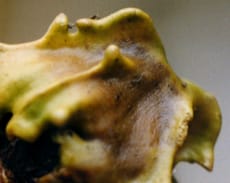
Ostracism - Nakedness - Bursting rage - Risk - Ugly - Homesickness - Emptiness - Curtain - Euphoric - Death
Proving Themes
Kingdom: Animalia
Phylum: Arthropoda
Class: Insecta
Order: Hymenoptera
Family:
Kingdom Taxonomy
The word Knopper comes from the German word 'Knoppe' meaning a flat cap or helmet that was worn during the 17th Century.

.jpg)
